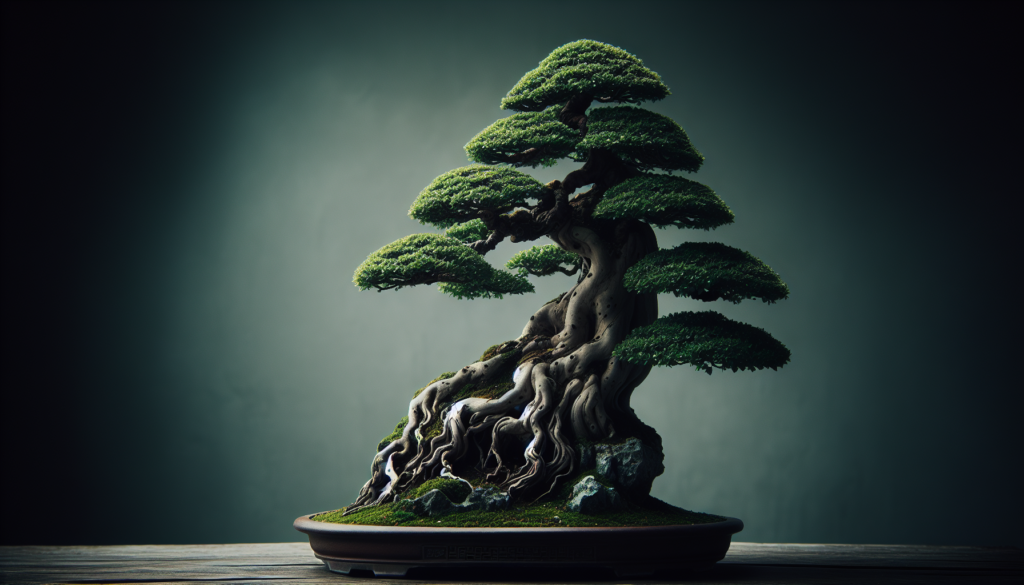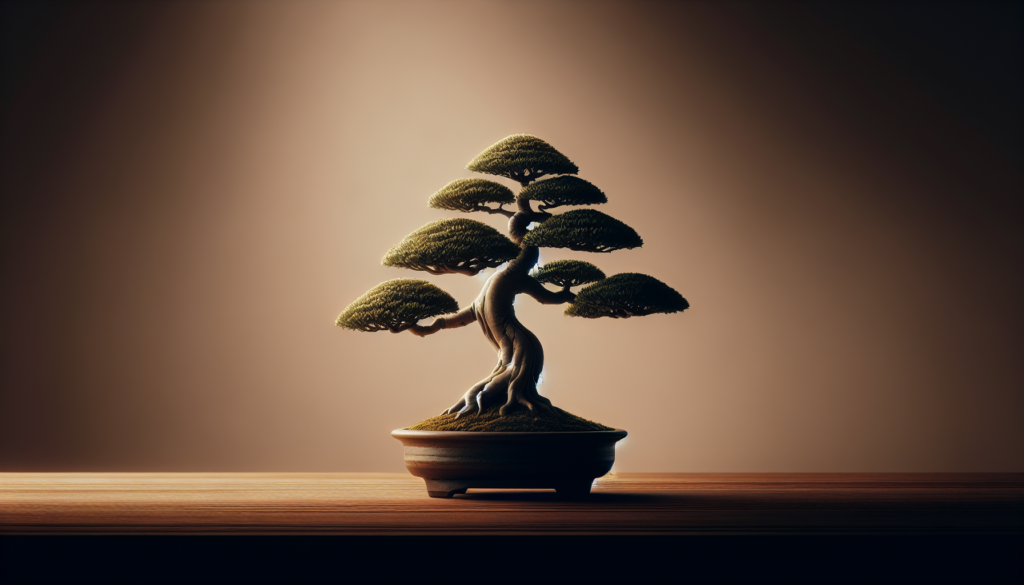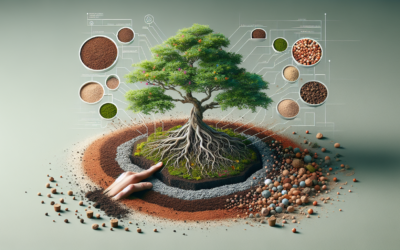Step into the enchanting world of bonsai and discover the delicate art of cultivating miniature trees. In this captivating article, you’ll explore the fascinating techniques used to create these living artworks that embody tranquility and beauty. From the careful pruning and shaping of branches to the thoughtful selection of pots, every aspect of bonsai cultivation is an intricate dance between the gardener and nature itself. Join us on this journey and unlock the secrets to creating your own tiny oasis of nature, while also discovering the unexpected joy of attracting birds and bees to your bonsai garden.
The Origins of Bonsai
Understanding the roots of bonsai
Bonsai, a form of art that involves cultivating miniature trees, has a rich history that can be traced back thousands of years. The origins of bonsai can be found in ancient China, where it was known as “penjing.” It was during the Tang dynasty that penjing gained popularity, as it was seen as a form of art that could bring nature indoors. Eventually, this art form made its way to Japan, where it was further refined and developed into what we now know as bonsai.
Influence of Chinese and Japanese culture
Both Chinese and Japanese cultures played significant roles in shaping bonsai into the art form it is today. In China, penjing served not only as a way to bring nature indoors but also as a representation of the harmony between humans and nature. The Japanese, on the other hand, focused on creating a more natural look for their miniature trees, which reflected their reverence for the beauty of nature. Throughout history, Chinese and Japanese artists exchanged ideas and techniques, further enriching The Art of Bonsai.
How bonsai became popular worldwide
Bonsai gained international attention and popularity in the 19th century. Western visitors to Japan marveled at the beauty and intricacy of bonsai trees and brought them back to their home countries. This sparked a fascination with bonsai in the Western world, leading to the establishment of bonsai clubs and societies dedicated to the cultivation and appreciation of these miniature trees. Today, bonsai has spread to every corner of the globe, with enthusiasts and artisans continually pushing the boundaries of the art form.
The Basics of Bonsai
The definition of bonsai
Bonsai, which translates to “tray planting,” involves the careful cultivation and artistic shaping of a tree in a miniature form. It is not simply a small potted plant but rather a living art form that requires meticulous care and craftsmanship. Bonsai trees are cultivated to mimic the shape and proportions of their full-sized counterparts, creating the illusion of age and maturity in a small-scale setting.
The principles of cultivating bonsai
Cultivating bonsai requires an understanding of several key principles. First and foremost is the concept of “tree essence,” which refers to capturing the essence of a full-sized tree in miniature form. This involves careful attention to the tree’s shape, trunk thickness, branch structure, and overall balance. Second, bonsai must adhere to the principle of “less is more,” where simplicity and minimalism are valued over complexity. Lastly, bonsai cultivation requires patience and a long-term vision, as it can take years or even decades to achieve the desired aesthetic.
Various styles of bonsai trees
Bonsai trees can be classified into various styles, each representing a different aspect of nature. Some common styles include formal upright, informal upright, slanting, cascade, semi-cascade, literati, windswept, and group planting. Each style requires careful consideration of the tree’s natural growth pattern and a keen eye for design. By selecting the appropriate style, bonsai enthusiasts can create visually striking and harmonious compositions.
Popular tree species for bonsai
While almost any tree or shrub can be cultivated as a bonsai, certain species are more popular due to their adaptability and aesthetic appeal. Some common tree species used in bonsai include juniper, pine, maple, ficus, elm, azalea, and cherry. Each species has its unique characteristics and care requirements, and it is important to choose a tree species that is suitable for your climate and environment.

The Artistic Considerations of Bonsai
Understanding the aesthetics of bonsai
Bonsai is not only a horticultural practice but also an art form that is deeply rooted in aesthetics. When creating a bonsai tree, it is important to consider elements such as proportion, balance, harmony, and movement. The overall design of the tree should evoke a sense of natural beauty and evoke an emotional response from the viewer. By understanding and applying the principles of aesthetics, bonsai artists can create living works of art that resonate with observers.
Incorporating the principles of balance and contrast
In bonsai, balance and contrast are essential for creating visually pleasing compositions. Balance refers to the distribution of visual weight within the tree, with the aim of creating a harmonious and stable appearance. This can be achieved through careful positioning of branches and foliage. Contrast, on the other hand, involves the juxtaposition of different elements, such as dense foliage against open spaces or light-colored bark against a dark background. By skillfully incorporating these principles, bonsai artists can create dynamic and captivating compositions.
Creating miniaturized yet realistic trees
One of the unique challenges in bonsai cultivation is creating miniaturized yet realistic trees. Bonsai artists strive to mimic the natural growth patterns of full-sized trees while reducing them in scale. This involves careful pruning, wiring, and shaping techniques to manipulate the tree’s form and create the illusion of age and maturity. By paying close attention to the tree’s trunk, branches, and foliage, bonsai artists can create remarkably lifelike miniature landscapes.
The Procedures of Bonsai Cultivation
Choosing a suitable tree
The first step in bonsai cultivation is selecting a suitable tree. It is important to choose a tree species that is compatible with your climate and environment. Additionally, consider the tree’s age and health, as older trees with well-developed trunks and branches are often preferred. Young nursery-grown trees are a popular choice for beginners, as they provide a blank canvas for shaping and training.
Creating the initial style
Once you have chosen a suitable tree, the next step is to create the initial style. This involves evaluating the tree’s natural growth pattern and determining the desired shape and form. In bonsai, there are several basic styles to choose from, such as upright, slanting, cascading, and windswept. By carefully pruning and wiring the tree’s branches, you can begin to shape it into the desired style.
Pruning techniques
Pruning is a fundamental technique in bonsai cultivation. It involves selectively removing branches and foliage to achieve the desired shape and form. There are several pruning techniques used in bonsai, including branch pruning, tip pruning, and leaf pruning. Each technique serves a specific purpose, such as encouraging back budding, creating finer ramification, or reducing the tree’s overall size.
Wiring and shaping techniques
Wiring is another important technique in bonsai cultivation, as it allows for precise control over the tree’s shape and form. Copper or aluminum wire is wrapped around the branches and trunk of the tree, gently bending them into the desired position. It is important to exercise caution when wiring, as excessive force can cause damage to the tree. Once the branches are shaped, the wire is left in place until the tree sets into its new form.
Using pots and soil
The choice of pots and soil is crucial in bonsai cultivation. Bonsai pots come in various shapes, sizes, and materials, each contributing to the overall aesthetic of the tree. The soil used in bonsai must provide adequate drainage and retain moisture without becoming waterlogged. Bonsai soils are typically a mixture of organic and inorganic components, such as Akadama, pumice, and lava rock. It is important to choose a soil mixture that suits the specific needs of your tree species.

The Maintenance of Bonsai Trees
Optimum conditions for growth
To ensure the optimal growth of bonsai trees, it is important to provide them with the right conditions. Most bonsai trees thrive in outdoor environments, where they can receive ample sunlight and fresh air. However, some tropical species may require indoor or greenhouse cultivation in colder climates. Additionally, bonsai trees have specific temperature, humidity, and air circulation requirements that should be maintained to keep them healthy and thriving.
Watering guidelines
Proper watering is crucial for the health and vitality of bonsai trees. It is important to water bonsai trees thoroughly but avoid overwatering, as this can lead to root rot and other issues. The frequency of watering depends on factors such as the tree species, pot size, climate, and season. Bonsai trees should be watered when the topsoil feels slightly dry to the touch, ensuring that water penetrates the entire root system.
Fertilizing procedures
Bonsai trees require regular fertilization to replenish essential nutrients and promote healthy growth. There are various fertilizers available specifically formulated for bonsai, including liquid fertilizers, slow-release pellets, and organic options. The frequency and strength of fertilization depend on the tree species, season, and the overall health of the tree. It is important to follow the manufacturer’s instructions and avoid overfertilization, as this can damage the tree’s delicate root system.
Repotting techniques
Repotting is an essential maintenance procedure in bonsai cultivation. It involves carefully removing the tree from its current pot, trimming the roots, and placing it into a new pot with fresh soil. Repotting helps rejuvenate the tree’s root system and promotes overall health and vigor. The frequency of repotting depends on the tree species and its growth rate but generally occurs every one to three years. It is important to follow proper repotting techniques and timing to minimize stress to the tree.
The Health of Bonsai Trees
Common pests and diseases
Like any plant, bonsai trees are susceptible to pests and diseases. Common pests that can affect bonsai include aphids, scale insects, spider mites, and mealybugs. These pests can cause damage to the foliage, weaken the tree, and disrupt its overall health. Bonsai trees are also prone to diseases such as root rot, fungal infections, and bacterial infections. Regular inspection and prompt treatment are essential in preventing and mitigating the impact of pests and diseases.
Preventative measures
To maintain the health of bonsai trees, it is important to take preventative measures to minimize the risk of pests and diseases. This includes regular inspection of the tree for any signs of infestation or illness, maintaining proper hygiene in the bonsai environment, and providing appropriate growing conditions. Proper watering, fertilization, and pruning techniques can also help strengthen the tree’s natural defenses and reduce its susceptibility to pests and diseases.
Treatment options
When pests or diseases are identified, prompt treatment is necessary to prevent further damage to the bonsai tree. There are various treatment options available, including chemical and organic insecticides, fungicides, and bactericides. It is important to choose the appropriate treatment for the specific pest or disease, following the instructions carefully to avoid harming the tree or the environment. In some cases, it may be necessary to consult with a professional bonsai specialist or local agricultural extension service for guidance.
Advanced Bonsai Techniques
Integrating deadwood features
Integrating deadwood features, such as hollows, scars, and weathered bark, can add a sense of age and character to bonsai trees. Deadwood techniques involve carefully carving and sculpting the wood to create natural-looking features that mimic the effects of time and weather. This technique requires precision and artistic vision to achieve the desired effect while ensuring the tree’s continued health and vitality.
Incorporating shari and jin
Shari and jin are two other techniques used to enhance the aesthetic appeal of bonsai trees. Shari refers to the deliberate removal of bark from a section of the trunk, creating a prominent vertical feature. Jin, on the other hand, involves stripping bark and branches to create a deadwood branch or tip. These techniques can help create a sense of drama, movement, and age in bonsai trees, adding visual interest and evoking a deeper connection with nature.
Application of grafting techniques
Grafting is a technique used to introduce new branches or foliage onto bonsai trees. It involves connecting a scion, which is a small shoot or bud, onto an existing branch or trunk. Grafting allows bonsai artists to add variety and create unique compositions that may not be achievable through traditional methods. This advanced technique requires a deep understanding of the physiology of the tree and careful execution to ensure successful grafting and integration.
Display and Exhibition of Bonsai
Guidelines on presenting bonsai
Presenting bonsai involves carefully selecting suitable display tables, stands, and accents to showcase the beauty of the trees. Bonsai should be displayed in a way that complements their size, shape, and style, ensuring they are the focal point of the display. The choice of pots, display accessories, and background elements should enhance the overall aesthetic and create a harmonious composition. It is important to consider the principles of balance, contrast, and scale when presenting bonsai.
Interpreting bonsai displays
Interpreting bonsai displays requires an understanding of the artistic principles and cultural context behind the trees. Each bonsai display tells a story, conveying themes such as seasonal changes, natural landscapes, or symbolic representations. The arrangement of multiple bonsai trees within a display can create a sense of harmony, dialogue, or tension. By carefully observing and analyzing the elements within a bonsai display, viewers can gain a deeper appreciation for the artistry and intention behind it.
Learnings from bonsai competitions and exhibitions
Bonsai competitions and exhibitions provide valuable opportunities for bonsai enthusiasts to showcase their skills, learn from others, and gain recognition in the community. These events often feature expert judges who evaluate the trees based on criteria such as shape, styling, and overall health. Participating in or attending bonsai competitions and exhibitions allows individuals to stay informed about the latest trends, techniques, and artistic approaches in the world of bonsai.
Bonsai and Mindfulness
The therapeutic effects of bonsai
Bonsai cultivation has been found to have various therapeutic effects on individuals, promoting relaxation, stress relief, and mental wellbeing. Taking care of bonsai trees requires focus, patience, and a deep connection with nature. The act of nurturing and shaping these miniature trees can serve as a meditative practice, providing an escape from daily stressors and fostering a sense of tranquility. Engaging in bonsai cultivation can be a mindful and therapeutic activity for individuals seeking balance and inner peace.
Exploring the bonsai-Zen connection
Bonsai and Zen philosophy share a deep connection, both emphasizing simplicity, harmony, and a profound respect for nature. Bonsai cultivation can be seen as a reflection of Zen principles, as it requires focused attention to detail, present-moment awareness, and a deep respect for the natural world. The harmonious balance achieved in bonsai mirrors the Zen concept of finding inner peace through the appreciation of simplicity and serenity.
The role of bonsai in calming and stress relief
The process of caring for bonsai trees can have a calming and stress-relieving effect on individuals. The act of pruning, wiring, and shaping the tree requires patience and focus, which can help divert the mind from daily worries and concerns. The slow and deliberate nature of bonsai cultivation encourages individuals to be present in the moment and find solace in the simplicity of nature. Engaging with bonsai can provide a much-needed respite from the fast-paced and often stressful modern world.
Bonsai and Wildlife
How bonsai attract birds and bees
Bonsai trees, particularly those with flowers or fruit, can attract birds and bees to the surrounding environment. The vibrant colors, nectar, and shelter provided by the bonsai can be irresistible to these pollinators. Birds may perch on the branches, sing their songs, and even build nests within the bonsai. Bees, on the other hand, are drawn to the flowers and play a crucial role in pollination. Bonsai cultivation can contribute to the biodiversity of an area by creating a welcoming habitat for these winged creatures.
Biodiversity-friendly practices in bonsai cultivation
Bonsai enthusiasts can adopt biodiversity-friendly practices to promote the wellbeing of wildlife and create a balanced ecosystem. This includes using organic fertilizers and pesticides that are safe for pollinators, providing sources of water for birds and insects, and planting companion plants that attract beneficial insects. Creating a biodiverse environment around bonsai trees can enhance their overall health, preserve natural habitats, and contribute to the conservation of local wildlife.
Impact of bonsai on local ecosystems
Bonsai cultivation, when done responsibly and in harmony with nature, can have a positive impact on local ecosystems. The presence of bonsai trees can provide a micro-environment for wildlife, contributing to the biodiversity and ecological balance of an area. Bonsai trees can also serve as educational tools, raising awareness about the importance of preserving natural habitats and the role individuals can play in protecting their local environment.
In conclusion, the art of bonsai encompasses a wide range of aspects, from its rich cultural history to its intricate cultivation techniques. Understanding the origins and influences of bonsai allows us to appreciate the depth and significance of this ancient art form. By mastering the basics of bonsai, exploring its artistic considerations, and implementing advanced techniques, individuals can create miniature trees that evoke a sense of awe and wonder. Moreover, bonsai cultivation offers therapeutic benefits, fosters mindfulness, and contributes to the well-being of both humans and wildlife. By embracing the principles of balance, harmony, and respect for nature, bonsai enthusiasts can embark on a lifelong journey of creating living works of art that bring joy and serenity to their surroundings.








